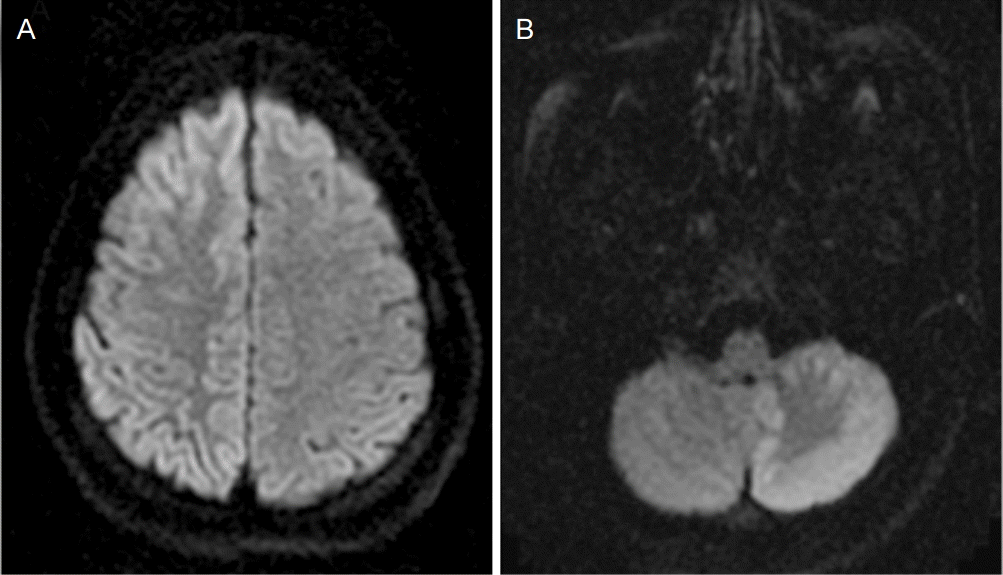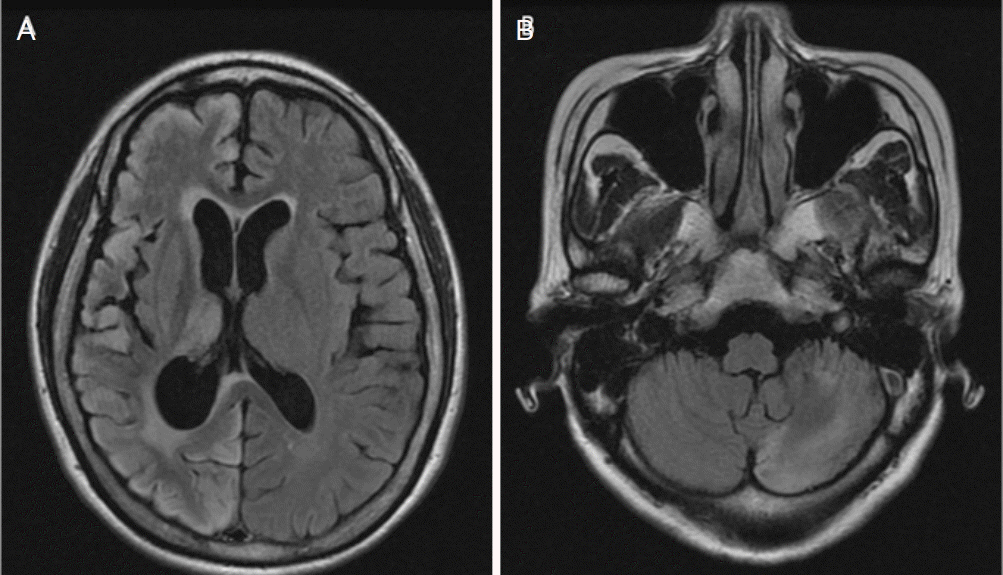Abstract
Background:
Status epilepticus (SE) may be associated with increased intensity in the cerebral cortex as observed on diffusion-weighted and fluid-attenuated inversion recovery magnetic resonance imaging (MRI). Rarely, this change in intensity also occurs in the contralateral cerebellum, although the pathophysiology of this phenomenon in epilepsy is not fully understood. Here, we present a case of crossed cerebellar diaschisis in convulsive status epilepticus and discuss the changes in serial MRI findings.
Case Report:
A 48-year-old female patient was admitted to our hospital. She experienced an intermittent seizure every couple of months since infancy. One month before her admission, she discontinued the anticonvulsant medication by herself. On the admission day, she was found by her son in comatose mental status with a convulsive seizure involving the left side of the body. The seizure was controlled after administration of lorazepam and intravenous loading of levetiracetam. Brain MRI showed diffusion restriction in the right frontal lobe and left cerebellar hemisphere. The symptom of left hemiparesis persisted. Follow-up MRI was performed after 1 month, and it showed an atrophic change in the right hemisphere and diffuse cortical laminar necrosis with a mild atrophic change in the left cerebellar hemisphere.
뇌전증지속상태(Status epilepticus, SE)는 장시간 지속되거나 여러 차례 반복되는 뇌전증 발작이다. SE는 뇌에서 취약한 부위의 넓은 신경세포 괴사를 일으킬 수 있고, 이는 인간에서의 신경병리 연구와 동물실험 연구에서 밝혀졌다. SE에서 취약한 뇌부위는 해마(hippocampus), 편도(amygdala), 조롱박피질(piriform cortex), 소뇌 피질, 시상, 대뇌 피질 등이다[1]. SE에서 확산강조영상(diffusion-weighted image, DWI)와 fluid-attenuated inversion recovery (FLAIR)에서의 비정상적인 소견에 대한 보고들이 늘어나고 있다. 영상검사 상 소견들은 주로 대뇌 피질과 시상에 걸쳐 넓게 분포하고, crossed cerebellar diaschisis (CCD)와 동반되기도 한다[2]. 현재까지 CCD의 유무와 예후 사이의 관계에 대한 보고는 없는 상태이다. 하지만 magnetic resonance imaging (MRI) 상의 이상소견이 아급성 시기까지 유지되는 환자에서 비가역적인 신경세포 손상이 관찰되었다는 보고가 있다[3]. 저자들은 SE 환자에서 비정상적인 영상 소견과 동반된 CCD에 대한 증례를 경험하여 이에 대해 보고한다.
49세 여자가 뇌전증지속상태로 응급실로 내원하였다. 1세 때 부터 2-3개월 마다 1차례씩 발작이 있었으며, 내원 10여 년 전부터 발작의 빈도가 증가하여 항경련제를 복용하였다. 평소 매일 소주 한두 병씩 마셨으며, 내원 4년 전 처음으로 SE로 입원치료 후 본원에서 통원하며 항경련제 처방을 받아 복용하였다. 내원 1개월 전부터 자의로 항경련제 복용을 중단하였고, 내원 당일 아들에 의해 좌측 반신의 발작을 동반한 혼수상태로 발견되었다. 내원 후 lorazepam 정맥 주사 및 levitracetam 주사 후 발작은 멈추었고, 이후 재발하지 않았다. 뇌 MRI를 촬영하였으며 확산강조 영상에서 우측 대뇌반구 및 좌측 소뇌의 확산 제한(diffusion restriction)이 관찰되었다(Fig. 1). 이후 의식은 회복되었으나 좌측 반신마비는 지속되었다. 1개월 후 뇌 MRI 추적검사를 시행하였고, 우측 대뇌 반구의 위축 및 좌측 소뇌의 넓은 부위에 걸친 층상피질괴사(laminar cortical necrosis)가 관찰되었다(Fig. 2).
SE는 지속적인 신경세포의 활성 및 과다한 글루탐산염(glutamate)에 의해 나타나며, 이는 신경절 후 N-methyl-D-aspartate(NMDA) 수용체를 활성화하여 수용체에 의한 칼슘 유입을 야기한다. 이러한 작용은 세포독성과 연관이 있고 그에 따른 세포사멸에 중요한 역할을 한다[1,4]. 소뇌는 푸르킨예세포(Purkinje cell)에서 억제물질인 gamma amino butyuric aci (GABA)를 분비함으로써 간질발작에 대한 억제작용을 한다. 전신발작이 잦은 심한 뇌전증 환자에서 푸르킨예세포의 소실이 관찰되는데, 이는 억제작용에 대한 요구가 많음을 의미하고, GABA의 소실과 그로 인한 세포 내 과다한 칼슘의 유입으로 인한 세포 사멸에 의한 것이다[1].
이와 같은 뇌 손상은 뇌 MRI 상에서 나타날 수 있으며, 대부분 가역적이지만 때로 비가역적인 손상을 보이기도 한다. 또한 발작에 의한 뇌 MRI 소견의 변화와 동시에 반대측 소뇌의 손상이 동반되기도 하는데 이는 CCD에 의한 것이다[1,4]. 편측 대뇌 반구에 존재하는 병변과 동반된 반대측 소뇌의 위축(crossed cerebellar atrophy)은 이미 오래 전부터 알려져 있었으나 그 병태생리에 대한 이해는 아직 불완전한 상태이다. 5 1980년, 대뇌의 경색이 있는 환자에서 시행한 양전자방출단층촬영(positron emission tomography)에서 반대측 소뇌의 대사 감소가 관찰되었고, 이를 CCD라고 명명하였다. 현재까지 피질-뇌교-소뇌 경로(corticopontocerebellar pathway)의 손상이 CCD의 발병 원인이라는 것이 대다수의 견해이다[5]. SE에서 대뇌 반구에서 발생한 과다한 흥분성 자극이 피질-연수-소뇌 경로를 통해 반대측 소뇌 반구를 기능적으로 비활성화시킨다[6].
저자들은 뇌전증 환자에서 SE 이후 뇌 MRI에서 관찰된 우측 대뇌 반구의 손상과 그와 동반된 반대측 소뇌의 위축을 경험하였다. 추적검사 상 상기 병변은 소실되지 않고 비가역적인 손상을 남겼다. 본 증례에서 환자는 뇌전증 발작 중에 발견되었고, 정확한 지속시간은 알 수 없으나 최소 1시간 이상으로 추정된다. 이러한 긴 지속시간이 CCD 및 이후의 비가역적인 뇌 손상과 연관 있을 것으로 생각된다. 저자들은 뇌전증지속상태로 드물게 발생할 수 있는 CCD를 경험하였기에 보고한다.
REFERENCES
1. Men S, Lee DH, Barron JR, Muñoz DG. Selective neuronal necrosis associated with status epilepticus: MR findings. AJNR Am J Neuroradiol. 2000; 21:1831–42.
2. Ahn HS, Kim KK. Two cases of crossed cerebellar diaschisis with or without thalamic lesion on brain MRI in status epilepticus. J Epilepsy Res. 2014; 4:74–7.

3. Graffeo CS, Snyder KA, Nasr DM, Murphy ME, Carr CM, Hocker SE. Prognostic and mechanistic factors characterizing seizure-associated crossed cerebellar diaschisis. Neurocrit Care. 2016; 24:258–63.

4. Huang YC, Weng HH, Tsai YT, Huang YC, Hsiao MC, Wu CY, et al. Periictal magnetic resonance imaging in status epilepticus. Epilepsy Res. 2009; 86:72–81.

5. Teixeira RA, Li LM, Santos SL, Zanardi VA, Guerreiro CA, Cendes F. Crossed cerebellar atrophy in patients with prococious destructive brain insults. Arch Neurol. 2002; 59:843–7.

6. Zaidi SA, Haq MA, Bindman D, Mathur S. Crossed cerebellar diaschisis: a radiologic finding in status epilepticus not to miss. BMJ Case Rep. 2013; 2013:pii: bcr2013200478.




 PDF
PDF Citation
Citation Print
Print




 XML Download
XML Download